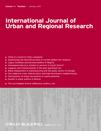 Gerade herausgekommen ist die aktuelle Ausgabe des International Journal of Urban and Regional Research, Vol. 35(1). Dort abgedruckt ist eine Besprechung zu John Gilderblooms Buch „Invisible City“ über einen Vergleich von verschiedenen wohnungsopolitischen Ansätzen in den USA:
Gerade herausgekommen ist die aktuelle Ausgabe des International Journal of Urban and Regional Research, Vol. 35(1). Dort abgedruckt ist eine Besprechung zu John Gilderblooms Buch „Invisible City“ über einen Vergleich von verschiedenen wohnungsopolitischen Ansätzen in den USA:
Invisible City: Poverty Housing and New Urbanism – By John Ingram Gilderbloom (pages 211–213)
John Ingram Gilderbloom 2008: Invisible City: Poverty Housing and New Urbanism . Austin: University of Texas Press.
Gilderbloom’s Invisible City is written against the background of 25 years of experience in housing research in the field of US housing policies. His book, many chapters of which were written in collaboration with colleagues, is based on numerous case studies and demonstrates through different dimensions of housing that ‘the private rental market alone cannot provide affordable housing for all citizens, and this is especially true for minorities’ (p. 200). Invisible City refers to the people ‘whom we walk past every day and never truly see’: the poor, disabled, elderly and homeless. Invisible City moves beyond and past the front stage of a city and looks backstage. Moreover, Invisible City refers to solutions to solve the housing crisis that are far removed from the usual agenda of housing policy. (…)
Leider ist der Online-Zugang der Beiträge nur den Abonnent/innen der Zeitschrift vorbehalten. Aber auch einige Universitäts-Bibliotheken haben einen uneingeschränkten Zugang zu den Beiträgen.
Als early view bereits online ist auch ein Beitrag von Armin Kuhn und mir zum Verhältnis der Hausebsetzungsbewegungen in Berlin zur Stadterneuerungspolitik:
Squatting and Urban Renewal: The Interaction of Squatter Movements and Strategies of Urban Restructuring in Berlin.
Abstract: Squatting as a housing strategy and as a tool of urban social movements accompanies the development of capitalist cities worldwide. We argue that the dynamics of squatter movements are directly connected to strategies of urban renewal in that movement conjunctures occur when urban regimes are in crisis. An analysis of the history of Berlin squatter movements, their political context and their effects on urban policies since the 1970s, clearly shows how massive mobilizations at the beginning of the 1980s and in the early 1990s developed in a context of transition in regimes of urban renewal. The crisis of Fordist city planning at the end of the 1970s provoked a movement of ‘rehab squatting’ (Instandbesetzung), which contributed to the institutionalization of ‘cautious urban renewal’ (behutsame Stadterneuerung) in an important way. The second rupture in Berlin’s urban renewal became apparent in 1989 and 1990, when the necessity of restoring whole inner-city districts constituted a new, budget-straining challenge for urban policymaking. Whilst in the 1980s the squatter movement became a central condition for and a political factor of the transition to ‘cautious urban renewal’, in the 1990s large-scale squatting — mainly in the eastern parts of the city — is better understood as an alien element in times of neoliberal urban restructuring.
Eine deutschsprachige Kurzfassung unseres Beitrags erschien bereits im vergangenen Jahr in der Monatszeitschrift Blätter für deutsche und internationale Politik, 3/2010, 107-115.


